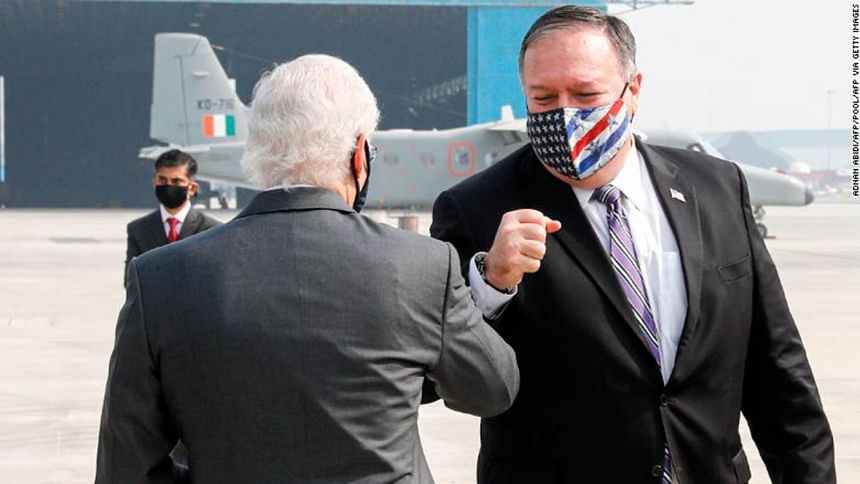BECA, the Indo-Pacific bandwagon and Bangladesh

Lenin once said that "there are decades where nothing happens and weeks where decades happen." Decades have indeed happened over the last few weeks that will affect the geopolitical scenario in so far as the Indo-Pacific is concerned. Domination of this region will determine who will dictate the future world order. And in jockeying for control, India has been made an integral part of the mechanism.
The much needed boost for India, both moral and in bilateral defence and military ties in the wake of the recent Indo-Chinese border confrontation has come in the form of BECA or the Basic Exchange and Cooperation Agreement, signed on October 27 in New Delhi, which will allow India and US to share geospatial information and enable interoperability of forces. The agreement will give India access to classified geospatial data as well as critical information having significant military applications from the US including use of drones. But apart from the moral aspect of it, the military intelligence that India will receive will be a force multiplier and add to the warning and standoff capability of its forces. Add to this the cooperation under the Five Eyes group for joint signal intelligence cooperation, that India hopes would accord it a military edge over China.
BECA, however, should be put in the context of the Indo-US strategy to counter China's increasing assertive posture in the Indo-Pacific region, in particular its naval expansion and establishing of naval bases in many of the 24 nations of the Indo-Pacific. The motivation is amply defined by India's foreign minister who said before the signing of the agreement, "Together, we can make a real difference when it comes to regional and global challenges, whether it is in respecting territorial integrity, promoting maritime domain awareness, countering terrorism or ensuring prosperity." No credit for guessing who the threat is from, and whose and what kind of interests might be threatened. The professed intention is to ensure a FOIP or a Free and Open Indo-Pacific.
India has already joined the quasi-military arrangement led by the US and which goes by the apt mnemonic QUAD of which Japan, Australia are the other two members—and it might be enlarged. Mahan has trumped over Mackinder in the US' and west's scheme of things, the focus shifting from Europe to the seas demonstrated by the declared intentions narrated in the US Indo-Pacific Policy and manifested both by the diplomatic forays and the joint naval exercises in the region.
The US' interest in the Indo-Pacific predates the US administration's current reinvigorated thrust in the region, South Asia in particular, going back to 2010 when Obama announced a "pivot" to Asia and two years later Hilary Clinton touted, "America's Pacific Century". The US Pacific Command (PACOM) has been renamed the Indo-Pacific Command (IPCOM). From mere promotion of a an economic concept—the Indo-Pacific Economic Corridor (IPEC), there is now a newly crafted US policy calling not only for a Free and Open Indo-Pacific (FOIP) but also leaving no doubt that force may be an option if that cannot be ensured through peaceful means.
The concept of the "Pacific Century" is compelled also by the forecast of the "Asian Century" where global geo-politics and economy would be driven by the three Asian powers, namely China, India and Japan. While the US has reconciled to the inevitability of the Asian Century, it hasn't as yet come to accept the idea of a US-dictated world order challenged by the aspiring world power—China. What thus far was a nebulous concept till June 2019, has been made very distinct, and one must read the fine print of the State Department's "US Policy on Indo-Pacific-2019" to get a clear impression of US motives and the likely measures it would employ to deny China the freedom of strategic and diplomatic manoeuvre in the region.
The Indo-Pacific has two important components that have motivated the shift of the centre of gravity of international geopolitics to the Indo-Pacific region. The two—economic and security—cannot be delinked since the former has been always the driver of foreign and security policy. The economic and commercial forecast about the region would attract any power disposed towards implementing a policy of domination to seek influence and control of the region's resources, through creating newer blocks of countries with similar geopolitical and economic interests. The newly formulated US plans do exactly that.
As for the geopolitical compulsions—between China's shedding of its self-imposed restrains as a part of Deng Xiao Ping's policy of keeping a low international profile while weaving through the path of China's economic modernisation—and Xi Jin Ping's assertive policy well beyond its region, backed by China's newly acquired economic and military clout and compelled by the need to keep the vital sea lanes open, has raised the hackles of the US and its close allies. Economically, China has already surpassed the US in terms of GDP based on purchasing power parity. And although, China's military potency is far behind that of US, China is the world's second-largest military spender, with a share of 14 per cent of global military expenditure. Its military spending in 2019 was 5.1 per cent higher than in 2018 and 85 per cent higher than in 2010 (SIPRI Fact Sheet April 2020). Its aspirations have gone beyond the immediate region and its footprints have reached beyond the continent of Asia. And in the greatest show of exercise of soft power, China has brought into its economic orbit 138 countries spread across all continents through its Belt and Road Initiative, thus challenging the lone global power status of the US. China's policy has drawn the US wrath which describe it as predatory economics. Thus the Indo-Pacific Policy and the reinvigorated US thrust in the Indo-Pacific region, to counter China.
Consequently, "In a major foreign policy shift, the Donald Trump administration is now looking at countries like Bangladesh, Sri Lanka and Maldives among others, not just for the purpose of business, but as key strategic partners under the Indo-Pacific construct, which is largely aimed at containing China", according to an Indian columnist. Inevitably, these developments have projected South Asia, Bangladesh in particular, at the forefront of big power contention for influence, with world and regional powers coming calling at its door in an attempt to get it on board in their contest to gain dominance on what will be the region of future geopolitical maelstrom and international competition, by reducing China's ever-growing influence. In South Asia India will exploit the US focus to reduce China's domination of the region.
The scramble for Bangladesh betrays the Indo-US strategic convergence in the Indo-Pacific and demonstrates the enhanced and renewed geopolitical salience of a country that was once considered an insignificant speck in the backwaters of the Bay of Bengal. Interestingly, the strategic reorientation of the US, from the Asia-Pacific to Indo-Pacific, has thrust not only Bangladesh but also the Bay of Bengal into the centre of attention, both being links between the west and the east, the former between South and South East Asia by land and the latter linking the two largest oceans, the Indian and the Pacific Oceans.
Although Bangladesh has expressed its disinclination to join any formal or pseudo military alliance, Bangladesh nevertheless is under pressure for joining the Indo-Pacific bandwagon. It will be a test of our diplomacy to chart a course that would keep us away from the power game through deft handling and judicious modulation of our policy in our effort to exist in the changed milieu allowing us the space for diplomatic manoeuvre, distancing from the ensuing power game yet deriving benefits from the economic component of the Indo-Pacific policy.
Brig Gen Shahedul Anam Khan, ndc, psc (Retd), is a former Associate Editor of The Daily Star.

 For all latest news, follow The Daily Star's Google News channel.
For all latest news, follow The Daily Star's Google News channel. 



Comments